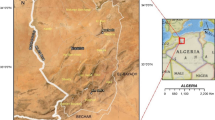This paper describes the use of a geographical information system (GIS) to construct environmental models for land-based aquaculture development in the State of Sinaloa, Mexico. Based on the source data, submodels were created focusing on three different themes: general environmental issues, water resources and water quality. Models enabled multicriteria and multiobjective decision making concerning site selection and location. In assessing site considerations these general models identified wider resource management options and solved conflicts of land allocation and land use between aquaculture and agriculture. Smaller-scale, more specific models enabled more detailed studies on environmental issues.
Similar content being viewed by others
References
Aguilar-Manjarrez, J. and Ross, L.G. (1993) Aquaculture development and geographical information systems. Mapping Awareness and GIS Europe 7(4), 49–52.
Ali, C.Q., Ross, L.G. and Beveridge, M.C.M. (1991) Micro computer spread sheets for the implementation of geographic information systems in aquaculture: a case study on carp in Pakistan. Aquaculture 92, 199–205.
Beveridge, M.C.M. (1987) Cage Aquaculture. Fishing New Books: Farnham, Surrey, pp. 102–148.
Burrough, P.A. (1986) Principles of Geographical Information Systems for Land Resource Assessment. Monograph on Soils and Resources Survey, No.12. Clarendon Press: Oxford, England. 186 pp.
Cosmocolor (1991) Estudio de Ordenamiento Ecológico para la Identificación de Zonas Con Vocación Acuícola en las Zonas Costeras. Region Huizache-Caimanero a San Blas. Documento Básico. Secretaria de Pesca. Subsecretaría de Fomento y Desarrollo Pesqueros. Dirección General de Acuacultura. México, D.F. 198 pp.
Eastman, R.J. (1993) IDRISI. A Grid Based Geographic Analysis System: Version 4.1, Update: Manual (Clark University Graduate School of Geography: Worcester, MA). 213 pp.
Ecoingeniería (1991) Estudio de Ordenamiento Ecológico para la Identificación de Zonas Con Vocación Acuícola en las Zonas Costeras de las Grullas Sinaloa a Mazatlán. la Etapa. Secretaria de Pesca. Subsecretaría de Fomento y Desarrollo Pesqueros. Dirección General de Acuacultura. Mexico, D.F. 316 pp.
Hopkins, J.S. and Sandifer, P.A. (1993) Development of environmentally sensitive shrimp aquaculture. In: From Discovery to Commercialization. European Aquaculture Society, Special Publication 19, Oostende, Belgium, p. 95.
Kapetsky, J.M. (1989) A Geographical Information System for Aquaculture Development in Johor State. FAO: Rome, FI:TCP/MAL/6754, Field Document, 62 pp.
Kapetsky, J.M., McGregor, L. and Nanne, H. (1987) A Geographical Information System and Satellite Remote Sensing Plan for Aquaculture Development: a FAO-UNEP/GRID Cooperative Study in Costa Rica. FAO: Rome, FAO Fisheries Technical Paper No.287. 51 pp.
Kapetsky, J.M., Hill, J.M. and Worthy, L.D. (1988) A geographical information system for catfish farming development. Aquaculture 68, 311–320.
Kapetsky, J.M., Wijkstrom, U.N., Macpherson, N.J., Vincke, M.M.J., Ataman, E. and Caponera, F. (1990) Where are the Best Opportunities For Fish Farming in Ghana? The Ghana Aquaculture Geographical Information System as a Decision Making tool. FAO: Rome, FAO Field Technical Report. 5, FI:TCP/GHA/0051.
Meaden J.M. and Kapetsky, J.M. (1991) Geographical Information Systems and Remote Sensing in Inland Fisheries and Aquaculture. FAO: Rome, FAO Fisheries Technical Paper No. 318.
Rao, M., Sastry, S.V.C., Yadar, P.D., Kharod, K., Pathan, S.K., Dhinwa, P.S., Majumdar, K.L., Sampat Kumar, D., Patkar, V.N. and Phatak, V.K. (1991) A Weighted Index Model for Urban Suitability Assessment—A GIS Approach. Bombay Metropolitan Regional Development Authority Bombay, India, pp.
Ross, L.G., Mendoza, Q.-M.E.A. and Beveridge, M.C.M. (1993) The application of site selection for coastal aquaculture: an example based on salmonid cage culture. Aquaculture 112, 165–178.
Saaty, T.L. (1977) A scaling method for priorities in hierarchical structures, Journal of Mathematics. Physiology 15, 234–281.
Secretaría de Pesca (1991) Anuario Estadistico de Pesca. Dirección General de Informática y Registros Pesqueros: México D.F. 150 pp.
Tarleton, J. (1994) A model for modernisation-INEGI: Mexico's national mapping agency. Mapping Awareness in the United Kingdom and Ireland 8(3), 40–41.
Zuñiga-Rodriguez, J. (1992) Crecimiento y Alimentación de Peces Marinos (familias Lutjanidae, Serranidae y Scianidae) en Semicultivo Con Jaulas Flotantes, en la Bahía de Topolobampo, Sinaloa. Informe de servicio social para obtener el título de Biólogo. Universidad Autónoma Metropolitana, Unidada de Xochimilco, México, D.F. 54 pp.
Author information
Authors and Affiliations
Rights and permissions
About this article
Cite this article
Aguilar-Manjarrez, J., Ross, L.G. Geographical information system (GIS) environmental models for aquaculture development in Sinaloa State, Mexico. Aquacult Int 3, 103–115 (1995). https://doi.org/10.1007/BF00117877
Issue Date:
DOI: https://doi.org/10.1007/BF00117877




